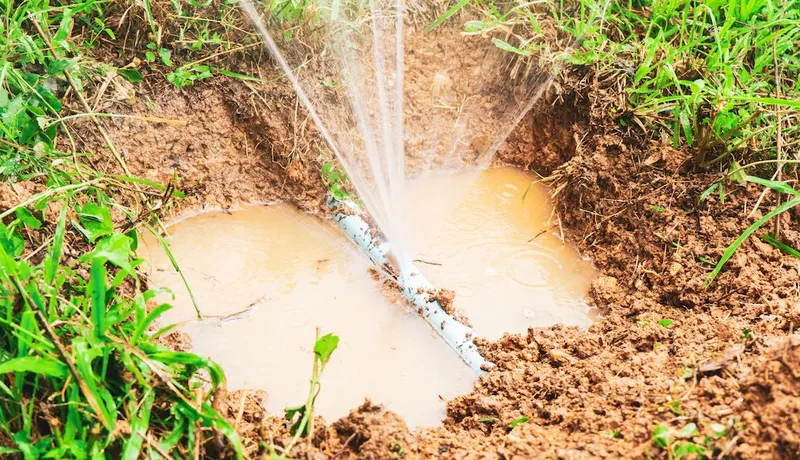Are you experiencing a sudden increase in your water bill? Do you suspect that there might be an underground water leak on your property? Finding and fixing an underground leak can be a daunting task, but with the right steps and a little detective work, you can identify and repair the problem without breaking the bank.
In this article, we will guide you through how to find underground water leak. By following these simple instructions, you can save both water and money while ensuring the integrity of your water system. So, let’s dive in and get started!

image – How to find underground water leak
Contents
What is underground water leak?
Underground water leaks refer to the seepage or leakage of water from pipes, plumbing systems, or infrastructure beneath the ground.
These leaks often go unnoticed for extended periods and can lead to significant water loss and damage to property if left unattended.
Common causes of underground water leaks include aging infrastructure, corrosion, pressure fluctuations, shifting soil, and natural wear and tear.
Detecting and repairing underground water leaks promptly is crucial to conserve water resources, prevent property damage, and reduce potential health hazards.
Signs of underground water leak
Wet Spots: One sign of an underground water leak is the presence of unexplained wet spots or puddles in your yard.
High water bills: Another indication of a possible underground water leak is an unusually high water bill that can’t be explained by increased usage.
Decreased water pressure: If you notice a decrease in water pressure throughout your home, it could be a sign of a hidden water leak underground.
Musty odors: A musty or moldy smell in certain areas of your home, especially near walls or floors, can indicate an underground water leak.
Improper Seals: Another cause of underground water leaks can be poor installation or improper sealing of pipe joints, which can lead to water seepage.
Tree roots: Tree roots can also be a major cause of underground water leaks, as they can infiltrate pipes, causing them to crack or break.
See Also – How does a water leak detector work? [full details]
Why is it important to find and fix an underground water leak?
Finding and fixing underground water leaks is important to conserve water resources and prevent waste.
Undetected underground water leaks can lead to significant property damage if left untreated for a long time.
Fixing water leaks helps to maintain stable water pressure in the plumbing system, ensuring efficient water usage.
Identifying and repairing underground water leaks can help save money on utility bills by reducing water consumption.
How to find underground water leaks by DIY method
here are 3 DIY methods to find underground water leak –
visual inspections
- When visually inspecting your property for water leaks, pay close attention to areas with visible pipes such as basements, crawl spaces, and utility rooms. Look out for any signs of corrosion or moisture around these pipes.
- Check all faucets and fixtures in your home during visual inspections. Make sure there are no drips or leaks coming from them when they are turned off.
- Inspect outdoor irrigation systems for leaks by looking for soggy or overly wet areas in your yard or garden.
- During visual inspections, don’t forget to check if there are any cracks or gaps in your foundation walls or floors which could be potential entry points for underground leaks.
Checking water meters
- To check your water meter for leaks, start by turning off all water-consuming appliances and faucets in your home. Take note of the current reading on the meter and wait for about an hour without using any water. If the meter reading has increased, it could indicate a hidden leak.
- Check for any unusual fluctuations in your water bill. A sudden increase in usage without any changes in your normal water consumption patterns could suggest an underground leak.
- If you suspect a leak but cannot identify its source, you can try conducting a visual inspection near your water meter. Look for any signs of dampness or pooling water around this area.
Using food colors
- To check for toilet leaks using food coloring, remove the tank lid and add a few drops of food coloring into the tank. Wait for about 15-20 minutes without flushing. If colored water appears in the toilet bowl, it means there is a leak from the flapper valve or overflow tube.
- For faucets and showerheads, apply a thin layer of food coloring to the area where the base meets the sink or wall. If any color seeps through, it indicates leaks that may require repair or replacement.
- To detect hidden pipe leaks, pour a few drops of food coloring into drain pipes and wait for about 10-15 minutes without using any fixtures. If color appears in toilets or sinks connected to those drain pipes, it suggests a hidden pipe leak somewhere in your plumbing system.
- You can also use this method to identify cracks or leaks in swimming pools by adding food coloring around suspected areas and observing if it gets pulled into cracks or flows out.
How do you find an underground water leak on your property?
One way to detect an underground water leak on your property is by monitoring your water bill. If you notice a sudden increase in your bill without any change in water usage, it could indicate a leak.
Another way to detect an underground water leak is by conducting a meter test. Turn off all faucets and appliances that use water, then check the meter. If it continues to run or show movement, it suggests possible leakage.
Using a listening device, such as a ground microphone, can help detect underground leaks. These devices amplify the sound of running water, allowing you to pinpoint the location of the leak.
Thermal imaging cameras are also effective in detecting underground water leaks. They can identify temperature differences caused by escaping water, helping you locate the source of the leak.
Conclusion
In conclusion, detecting underground water leaks can be a challenging task, but with the right tools and techniques, it is possible to identify and address these issues. Visual inspections, checking water meters, and using food coloring in toilets are simple DIY methods that can help detect leaks in specific plumbing fixtures.
Additionally, conducting a pressure test and monitoring your water bill can provide valuable insights into the presence of hidden leaks. However, it’s important to keep in mind that while these DIY methods are helpful, professional assistance may be necessary to accurately locate and fix underground leaks. By being proactive and addressing leaks early on, you can prevent further damage to your property and conserve water. So, don’t hesitate to take action if you suspect an underground water leak and ensure the integrity of your plumbing system.
Read Also:
- Transform Your Backyard Oasis: Hot Tub Privacy Solutions | backyard hot tub privacy ideas
- 10 Tips for choosing your Hot Tub
- How to winterize your pool?
- How to Naturally Clean Your Pool Water
- Detect an Underground Water Main Leak

My name is James A. Bright, and I have worked in the pool and plumbing industries for over 15 years. I started poolprosoutions.com to share my experience with you guys. Here, I provide helpful guides and tips related to pool care, hot tub care, underground water leaks, and pipe leaks.



